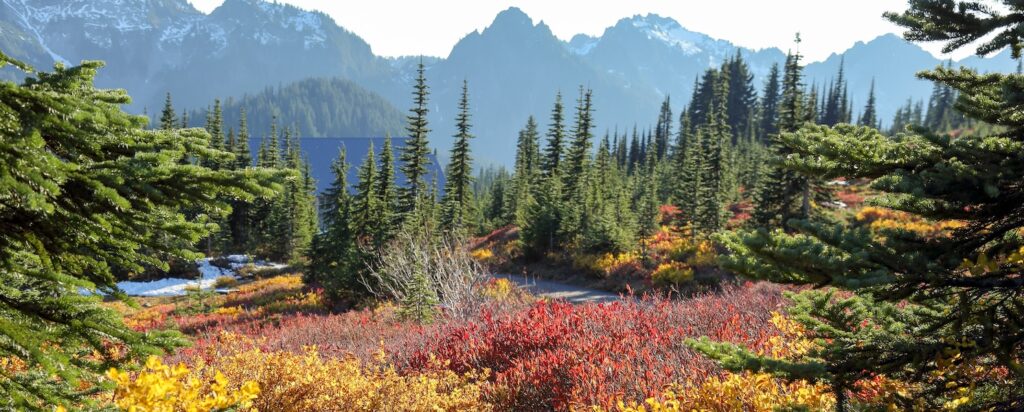Fall is one of the best times to experience Mount Rainier National Park. The summer rush is over, trailheads are easier to access, and the park shows off colors you won’t find at any other time of year. Vine maples, huckleberry bushes, and larches turn bright shades of red, orange, and gold, creating a completely different landscape than in July or August. Pair those fall colors Mount Rainier is famous for with crisp hiking weather, quieter scenic drives, and even opportunities for foraging, and you’ve got a season full of memorable things to do in fall. It’s easy to see why locals call autumn the park’s best-kept secret.
Already planning a fall trip? TMC Vacation Rentals in Packwood puts you just minutes from the Stevens Canyon entrance—meaning you’ll avoid Ashford’s long lines and have the perfect home base for exploring.
In This Article
- Mount Rainier Fall Colors
- Best Fall Hikes
- Scenic Drives
- Top Fall Photography Spots
- Foraging in Fall
- Fall Activities Near Packwood
- What to Pack for a Day in the Park
- FAQs
Mount Rainier Fall Colors
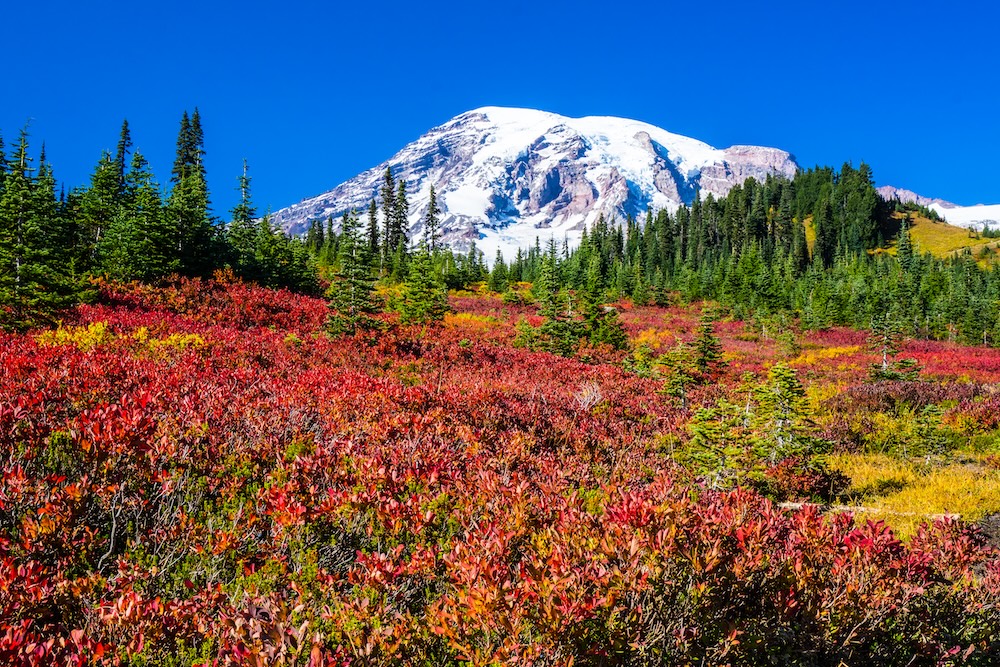
Every side of the mountain highlights a different take on autumn. Instead of endless forests of maples like you might see back east, Mount Rainier’s fall display mixes evergreens with bursts of color from shrubs and high-elevation trees. Vine maples turn fiery red, huckleberry bushes blanket the meadows in crimson, and western larch (tamarack) glow bright yellow against the dark green of fir and cedar. Lower down, you’ll spot cottonwoods, willows, elderberry, and aspen shifting into warm golds. Everywhere you look, the park is transformed with the colors of fall.
Best Time to See Fall Colors in Mount Rainier
Peak color typically runs from late September into early October, but this year’s warmer summer means the boldest leaves are expected closer to mid-October. At higher elevations, colors fade quickly once snow moves in, while lower valleys and passes can stay colorful into early November. If your dates are flexible, keep an eye on park webcams and recent trip reports to time your visit.
Best Places to See Fall Color
- Paradise: Easy access to meadows filled with vine maples and huckleberries, especially around the Henry M. Jackson Visitor Center.
- Sunrise & Chinook Pass: The east side turns early, with larches and huckleberry adding dramatic color around Tipsoo Lake and the Naches Peak Loop.
- Reflection Lakes & Bench Lake: Calm water creates mirror-like reflections of the mountain framed by fall foliage.
- Ohanapecosh Area: The Eastside Trail follows the Ohanapecosh River through old-growth forest, with bright vine maples adding fall color along the way.
- White Pass Scenic Byway (US 12): A favorite late-season drive, where tamarack and aspen light up the ridges in October and even into November.
Best Fall Hikes
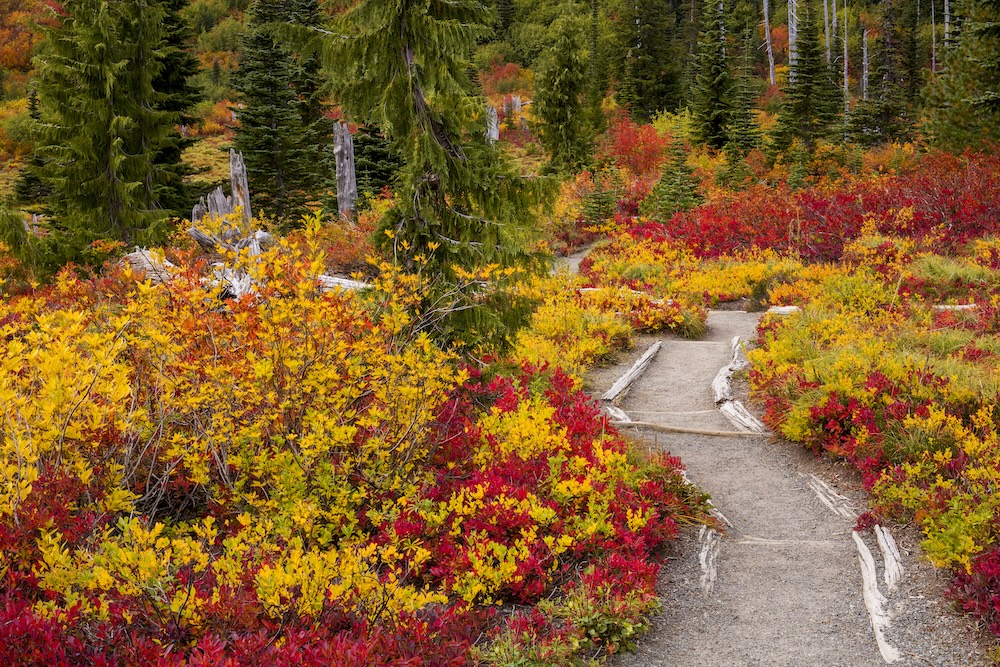
Hiking is one of the easiest ways to see Mount Rainier’s fall colors up close. Trails range from quick family-friendly walks to full-day treks, so you can match the outing to your schedule and comfort level.
Easy / Family-Friendly
- Myrtle Falls (Paradise): A short, paved trail leads to a 72-foot waterfall surrounded by gorgeous fall foliage, with Mount Rainier as the backdrop. About 1 mile round-trip from Paradise.
- Reflection Lakes: Just a short walk from the road, this spot offers some of the best lake views in the park. In fall, the shoreline grasses and shrubs reflect bright colors off the still water. Enjoy the views from roadside pullouts or make the 5-mile loop on the Lakes Trail.
- Narada Falls Trail: A short but steep path leads to a powerful 168-foot waterfall. The trail can be extended toward Reflection Lakes if you want a longer hike.
- Naches Peak Loop (Chinook Pass): At about 3 miles, this trail is a fall favorite. Meadows of huckleberry and views of Tipsoo Lake make it one of the most picture-perfect short hikes in the park.
- Christine Falls: A quick stop with a short walk to the viewpoint. The 60-foot falls are framed by the historic stone bridge, making it another of the park’s most photographed spots.
Moderate
- Skyline Trail Loop (Paradise): A 5.5-mile loop with steady elevation gain. In summer, it’s known for wildflowers, but in fall, the meadows turn red and orange. Parking fills early, so start in the morning.
- Sourdough Gap (Chinook Pass): Beginning near Sheep Lake, this 7-mile trail climbs to an overlook with sweeping views of Mount Rainier and distant Cascade peaks. Be sure to do this one before the season’s first snows.
Challenging
- Burroughs Mountain (Sunrise): Choose your turnaround—First Burroughs is 4.7 miles roundtrip, Second Burroughs about 7 miles. Both routes offer tundra-like terrain and close-up views of the Emmons Glacier.
- Crystal Peak (Chinook Pass): An 8-mile out-and-back hike featuring 3,100 feet of elevation gain, this trail winds you through old-growth forest to meadows and a rocky ridge. In the fall, it’s lined with mountain ash and asters bursting with color.
Scenic Drives
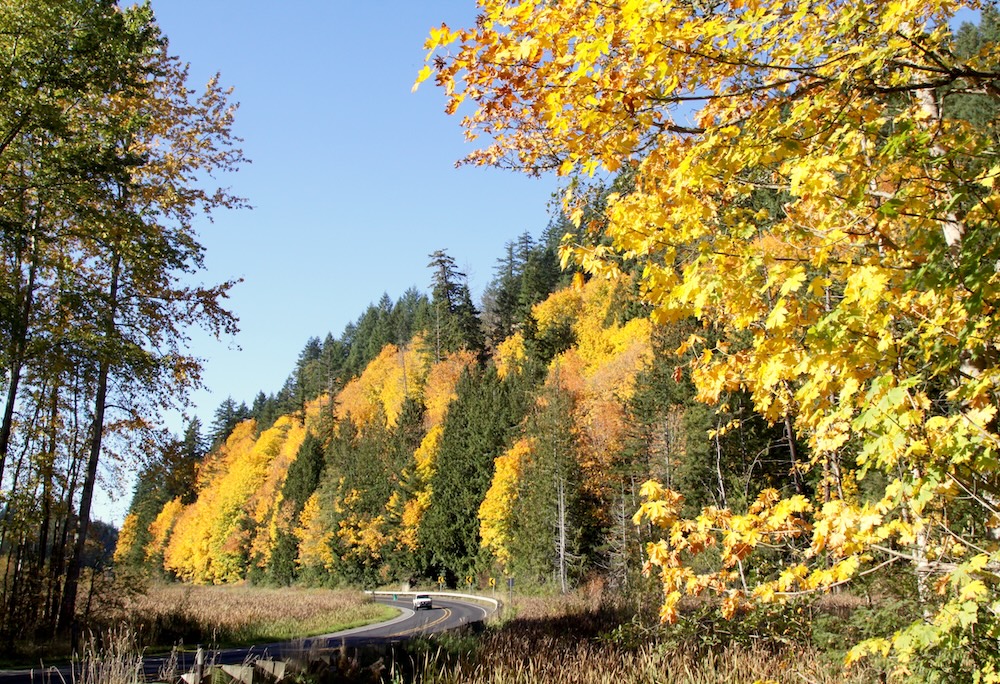
If hiking isn’t on your list, you can still enjoy the fall colors Mount Rainier is famous for—no boots required. These scenic drives show off the park’s autumn scenery from the comfort of your car, with plenty of pullouts for photos and picnics.
- Sunrise Road: Often called the most scenic drive in the park, this 15-mile route climbs to 6,400 feet, the highest point you can reach by car. The views of Rainier’s glaciers and surrounding ridges are unmatched, especially in October.
- Stevens Canyon Road: Connecting Paradise to the park’s southeast entrance near Packwood, this winding road packs in waterfalls, lakes, and overlooks. Narada Falls, Reflection Lakes, and several roadside pullouts make it easy to experience autumn without a long hike.
- Chinook Pass (State Route 410): One of Washington’s most beautiful mountain passes. The road crests near Tipsoo Lake, where meadows and ridgelines frame Rainier in full view. Later in October, the larches here add a gorgeous golden contrast.
- White Pass (U.S. Highway 12): Just east of Packwood, this route climbs steadily to 4,500 feet. The east side of the pass is especially colorful, with sweeping valley views.
By linking Stevens Canyon Road, Chinook Pass, and White Pass, you can create your own Mount Rainier scenic drive loop, with Sunrise Road as a worthwhile out-and-back side trip.
Top Fall Photography Spots
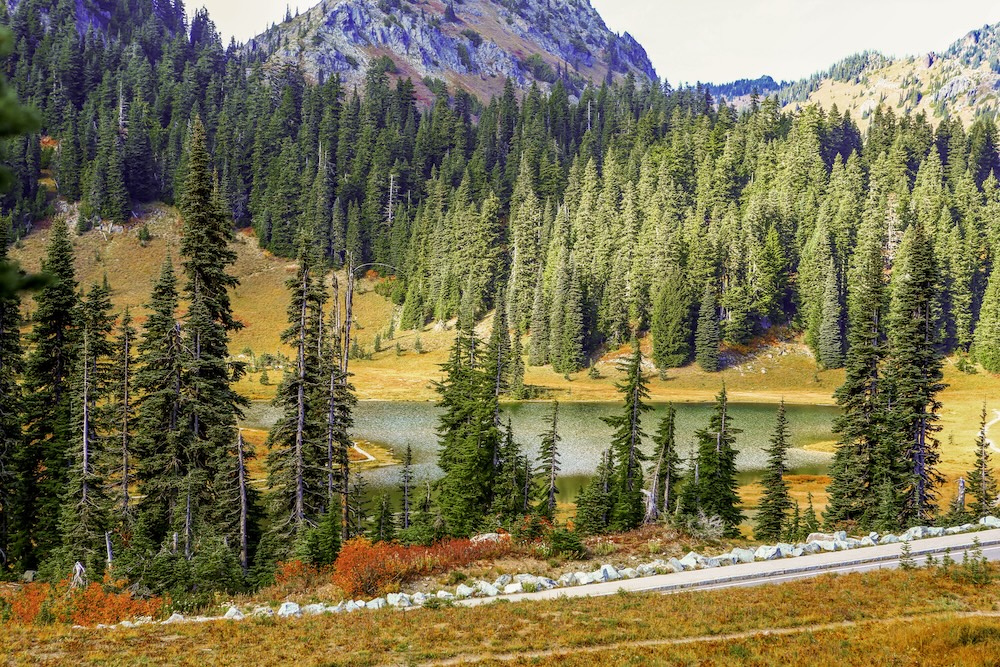
Some of the most photographed places in the park are even better in the fall. Reflection Lakes and Tipsoo Lake are two of the top spots for mirrored views of Rainier on still mornings, especially when the slopes are dotted with color. Up at Sunrise, wide-open views let you frame the mountain against ridgelines and valleys that glow with afternoon light. Along Stevens Canyon Road near Packwood, roadside pullouts offer angles on waterfalls, lakes, and sweeping views without having to hike for the shot.
For unique perspectives, try capturing close-up details of leaves or berries along the trails, or use the changing cloud cover through the day to add drama to wide landscape shots. A tripod is essential for low-light shots around sunrise and sunset, and macro lenses are great for getting super close-up details.
Foraging in Fall
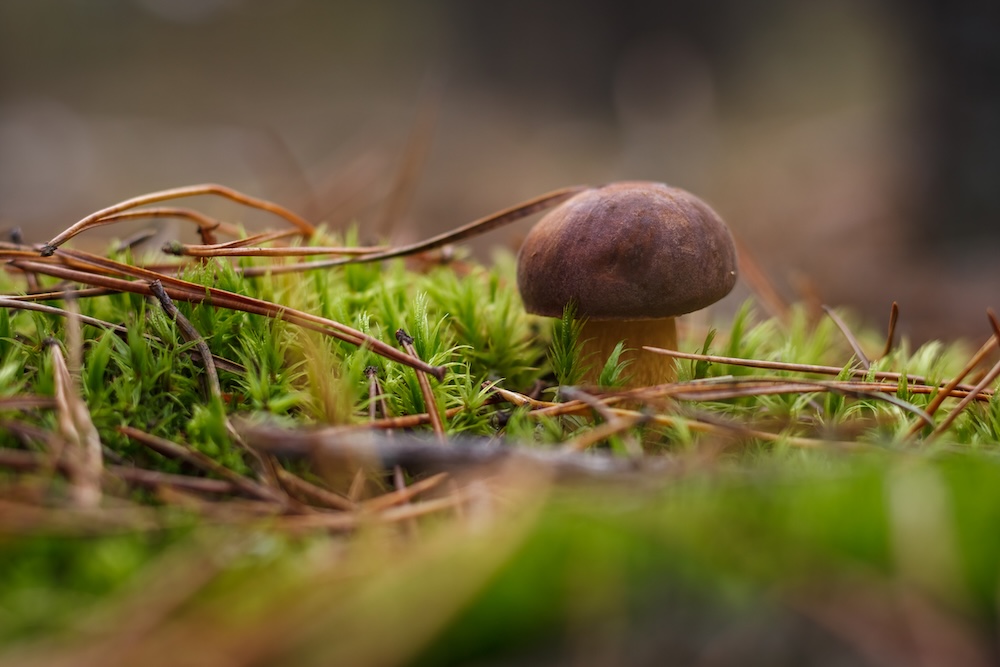
Fall isn’t just about the colors at Mount Rainier—it’s also one of the best times to explore the park’s wild foods. After the first rains, mushrooms start popping up in the forests, with the stretch between Narada Falls and Longmire being one of the best spots to forage. Chanterelles are the most common, but you may also come across boletes, matsutake, lobster mushrooms, shaggy mane, chicken-of-the-woods, and pig’s ear. Berry bushes like huckleberry and elderberry also linger into early fall, especially at lower elevations.
If you’re interested in mushroom hunting, know that it’s regulated: inside the park, you can collect up to one gallon per person per day for personal use, and only what’s visible above the ground. In the surrounding national forests, like Gifford Pinchot, a small free-use permit allows for a limited harvest, while larger quantities require a paid permit. Foraging for commercial use is never allowed inside the park. If you need help figuring out where to begin your foraging trek, a Washington mushroom hunting map can highlight popular areas and showcase which varieties are currently being found.
Safety is critical. Many edible mushrooms have toxic look-alikes, so unless you’re already confident in your identification skills, join a guided walk or stick to photography instead of eating what you find. If you’re worried you may have eaten a poisonous mushroom, seek immediate medical attention or contact the Washington Poison Center at 1-800-222-1222.
If you do harvest, the best way to carry fungi is in a breathable basket or paper bag, and a small knife makes clean cuts without damaging the growth beneath the soil. Remember, never take all the mushrooms in an area—leave some for other foragers to enjoy!
Fall Activities Near Packwood

Packwood may be small, but it’s a great base for fall adventures. Between time in the park, you can browse the Packwood Farmers Market for local produce and handmade goods (Saturdays, June through December) or stop into a café for coffee before heading out on a drive. October also brings special events worth planning around:
Gather + Grow Harvest Dinner
Celebrate the harvest season with a farm-to-table meal that supports East Lewis County’s Fresh Food Program. Dinner is crafted by Chef Corey of Vienna Gardens and features locally sourced ingredients. Guests can also enjoy live music, a silent auction, and a dessert dash.
- When: Sunday, October 19, 2025, 6–9 PM
- Where: Longmire Springs Brewing in Packwood, WA
- Cost: $85 per person (traditional or vegetarian meal option)
- Tickets
Gifford Pinchot Fungi Festival
A weekend-long celebration of mushrooms with guided foraging walks, educational workshops, art installations, and live music. Learn from experts, taste mushroom-based dishes, and take part in family-friendly activities.
- When: October 24–26, 2025
- Where: Longmire Springs Brewing in Packwood, WA
- Cost: Adults $200 weekend / $100 day pass; Students $100 weekend / $50 day pass; Children under 12 $50 weekend / $25 day pass
- Tickets
What to Pack for a Day in the Park
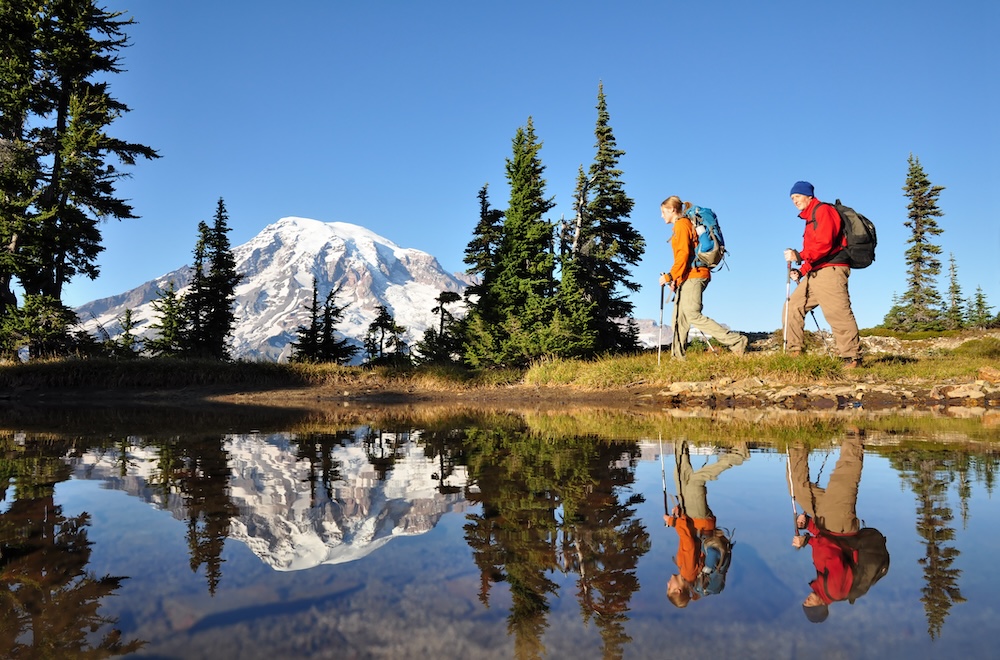
Days are shorter in the fall, and conditions can shift quickly at higher elevations. Here’s what to bring to stay comfortable and safe:
- Layers: Mornings can be near freezing, while afternoons warm up. A base layer, fleece or puffy, and a rain jacket will cover most situations.
- Headlamp or flashlight: Sunset comes around 5:30 PM in October, and trails get dark fast. Don’t count on your phone light.
- Offline maps: Cell service is unreliable. Download Google Maps or a trail map before heading out.
- Backpack cooler or packed lunch: Food options in the park are limited, and many close by early October. Inside the park, you’ll find two restaurants, two snack bars, a café, and a general store, but hours vary. Bringing your own snacks is cheaper and often more convenient.
- Water and reusable bottle: Even in cooler weather, hydration is key.
- Sturdy shoes or boots: Trails can be muddy, icy, or slick with leaves.
Stay Local with TMC Vacation Rentals
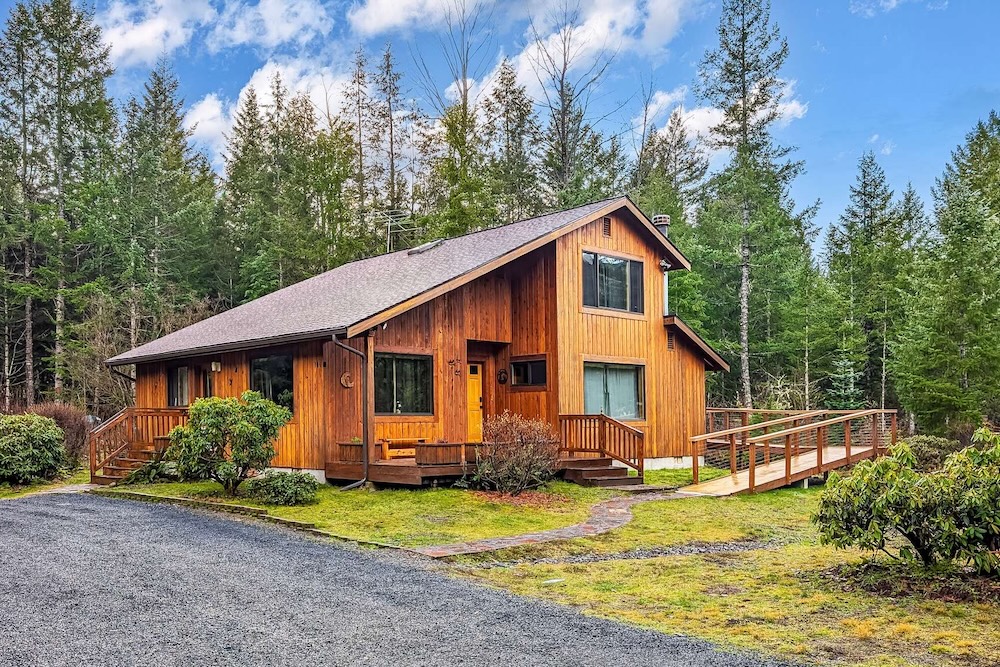
Featured Property: Mountain House
After a day of chasing fall colors, foraging for mushrooms, or winding through scenic drives, there’s nothing better than coming back to a space that feels like home. At TMC Vacation Rentals, we offer more than just a place to stash your bags. Our local team lives and works in Packwood, so we know the best trails, hidden spots, and seasonal events to make your trip special.
When you book directly with TMC, you can choose from pet-friendly cabins, rentals with private hot tubs, and cozy spaces designed with your comfort in mind. Discover the peace of mind that comes from working with area experts who care about your experience from start to finish.

